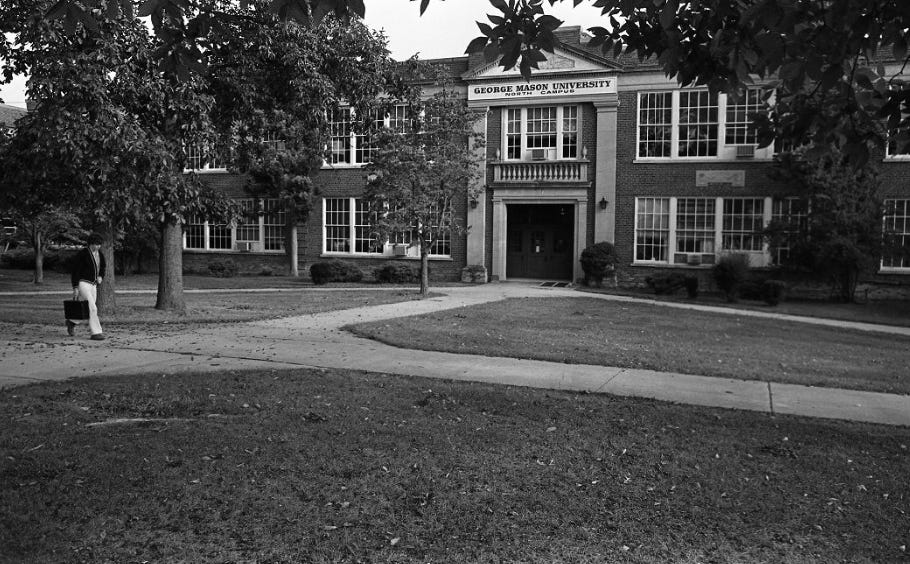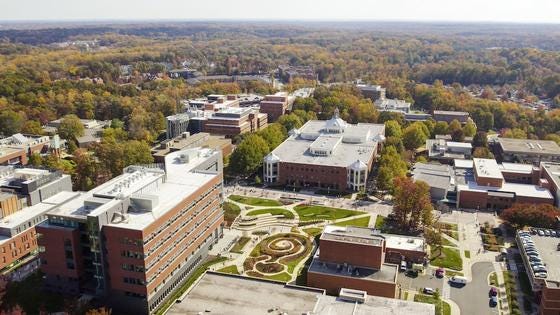Old School vs New School
College admissions today looks nothing like it did a generation ago.
The way it was vs the way it is.
APPLICATION DEADLINES
Old school → Regular decision. Apps due in January.
New school → Early applications. Apps due in early November.
Emphasis on Early Action (EA) and Early Decision (ED), with many deadlines in November. Applying early can enhance admission chances and access to scholarships.
TESTING
Old school → Mandatory SAT/ACT.
New school → Optional SAT/ACT.
Predominantly test-optional policies, though some elite institutions have reinstated requirements. As of 2025, over 80% of U.S. colleges remain test-optional or test-blind. Most students are not submitting test scores.
George Mason’s campus in the 1970s, which once occupied this Fairfax High School building, and today.
ADMISSIONS REVIEWS
Old school → GPA and grades, test scores, maybe extracurriculars.
New school → “Holistic review”.
Elevated interest in what is communicated about you via essays (and the overall application). Elevated importance of character traits.
APPLICATION VOLUME
Old school → Apply to a few schools
New school → Apply to many schools.
Students are now applying to an average of 6.65 colleges (via just the Common App - they may in fact be applying to more when you factor in UCs, Apply Texas, etc…).
DEMONSTRATED INTEREST
Old school → Minimal consideration of applicant’s interest.
New school → Active tracking of applicant’s engagement.
The consequence of almost all colleges being available on the Common App is students applying to more and more colleges. But, they can still attend only one.
Technology has enabled tracking, and colleges have embraced this. More colleges now care whether you are serious about attending, or not.
LEGACY ADMISSIONS
Old school → Legacy status provided a significant advantage.
New school → Don’t count on it.
There’s a growing movement to eliminate legacy preferences (e.g. an immediate relative such as a parent or grandparent graduated from the college); currently, states like Colorado, Maryland, Virginia, California, and Illinois have bans or restrictions on legacy admissions and many more higher ed institutions are under pressure to eliminate the practice.
AFFIRMATIVE ACTION POLICIES
Old school → Race-conscious admissions policies in place.
New school → Not allowed (a Supreme Court decision), and implications are still unfolding…
FINANCIAL AID CONSIDERATIONS
Old school → College is expensive
New school → Inflation-adjusted costs overall have decreased, but sticker-shock is real… Wellesley’s annual cost is >$100k!!!
Studies continue to show that a college degree is worth it (see - my previous blog). This is true whether you major in English or Engineering.
It doesn’t make it any easier to write those big checks, though.
And recent shake-ups in our government, coupled with new legislative proposals that change the college loans picture, mostly mean that paying for college is still going to be an issue for most.
AI + ADMISSIONS
Old school → Humans did all the work.
New school → Everyone is using AI.
Anyone can use ChatGPT to create a pretty compelling essay.
And any college can, and probably will, use AI to review your app, if only to try to tell if you used ChatGPT to write your essay.
The volume of applications is going up, and colleges are already starting to turn to AI to help with classification, summarisation, note taking, and even reviews of apps.
AI will predict which students will / won’t attend. It’ll also probably predict which students are most likely to be successful in college. And AI will certainly be used to figure out how much your family is willing to pay to attend college <sigh>, which will impact any financial aid and scholarship offers you receive.
There’s no going back… only looking forward.



